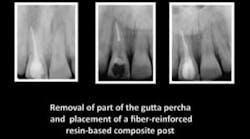by Cary J. Limberakis, DMD
A 16-year-old patient presented for his periodic maintenance and inquired whether anything could be done to make the white spots on his central incisors disappear. I described to him and his mother that these hypomineralized lesions could be treated in a noninvasive manner by remineralizing the affected areas utilizing MI Paste™ with RECALDENT™-CPP-ACP (GC America). Treatment for the white spot lesions began two weeks later.
Following the recommended protocol, the teeth were isolated, prophy cupped with plain pumice, etched for 30 seconds, and evaluated for the desired frosty appearance. These steps were repeated three to four times before proceeding with finger application of the MI Paste for 5 minutes at each office visit. The patient was treated in the office eight times over a period of six months, approximately every three to four weeks. The patient was instructed to apply MI Paste for 5 minutes twice daily after brushing. Patient compliance was not optimal, yet disappearance of the white spots progressed.
Dr. Cary Limberakis, a solo-practicing general dentist for more than 30 years in Jenkintown, Pa., graduated from the University of Pennsylvania School of Dental Medicine. He is active in organized dentistry, church and community affairs, is a clinical instructor at a local GPR program, and holds fellowships in the Academy of General Dentistry, and both the American and International Colleges of Dentists.
GC America Suggested White Spot Reversal Protocol*
• Suggest to take photos of white spot lesions prior to the start and at the conclusion of treatment.
• It is important not to over-etch the tooth surface; careful attention needs to be applied to the etching material, the concentration and application time. Some clinicians prefer to pumice first, then etch.
• Apply 35 - 37% phosphoric acid gel to the white spot lesions (10-15 seconds to 30 seconds, no longer than one minute); Be conservative when etching, you can always re-etch a second time if necessary; rinse.
• Apply the etch material on the white spot lesion being treated, not the entire tooth surface.
• For microabrasion, gently pumice for 10 to 30 seconds, non-fluoridated, non-glycerin pumice — suggest “Flour of Pumice”; rinse.
• Dry the tooth and review the effect; sometimes you may have to re-etch/pumice a second time; the tooth will appear frosty after the etch/pumice application.
• It is suggested for in-office to use a prophy cup to apply MI Paste; use your finger or a cotton tip to apply MI Paste for home application.
• Apply layer of MI Paste on the etched tooth surfaces; leave on the tooth surface a minimum of 5 minutes; you can’t overuse MI Paste; you can leave MI Paste on the tooth surface longer to maximize the uptake of calcium and phosphate; this applies to both in-office and at-home applications.
• Advise the patient not to eat or drink for 30 minutes, maximizing the uptake of the calcium and phosphate into the dental tubules.
• Instruct patient to apply MI Paste two times daily for a minimum of five minutes, remember you can’t overuse MI Paste; custom tray is optional.
• Note: it is suggested to refrain from ingesting staining products during the white spot reversal procedure since, after etching, the dental tubules are wide open and can easily pick up stains, therefore, no wine, tea, coffee, cola drinks, grape juice, tomato sauces, smoking, etc.
• Have patient return for evaluation in 7-10 days. Repeat the above procedures if necessary.
*We have seen very good results from many clinicians incorporating microabrasion techniques in their MI Paste practice. If you are a clinician that utilizes these techniques, please review the materials prior to use. Concentration of material and time of application should be considered and adjusted accordingly. Clinical cases have been submitted to GC America Inc. from various dental professionals; they are not affiliated with GC America Inc. We appreciate sharing Key Opinion Leaders’ clinical success cases with MI Paste, however, we at GC America Inc. do not make any official claim to their techniques. In regards to the length of time for etching, we suggest you follow the manufacturer’s recommendation and be conservative with the etching procedure.







